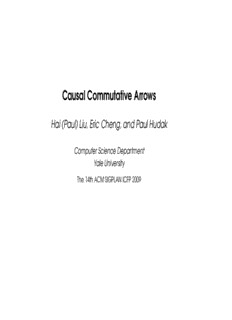
Causal Commutative Arrows - theV.net PDF
Preview Causal Commutative Arrows - theV.net
Causal Commutative Arrows Hai (Paul) Liu, Eric Cheng, and Paul Hudak Computer Science Department Yale University The 14th ACM SIGPLAN ICFP 2009 Example A mathematical definition of the exponential function: (cid:90) t e(t) = 1 + e(t) · dt 0 FRP program using arrow syntax (Paterson, 2001): exp = proc () → do rec let e = 1 + i i ← integral−≺ e returnA−≺ e Functional Reactive Programming Computations about time-varying quantities. Signal α ≈ Time → α Yampa (Hudak, et. al. 2002) is a version of FRP using the arrow framework (Hughes, 2000). Arrows provide: Abstract computation over signals. (cid:73) SF α β ≈ Signal α → Signal β A small set of wiring combinators. (cid:73) Mathematical background in category theory. (cid:73) What is Arrow A generalization of monads. In Haskell: class Arrow a where arr :: (b → c) → a b c (≫) :: a b c → a c d → a b d first :: a b c → a (b, d) (c, d) Support both sequential and parallel composition: second :: (Arrow a) ⇒ a b c → a (d, b) (d, c) second f = arr swap ≫ first f ≫ arr swap where swap (a, b) = (b, a) (???) :: (Arrow a) ⇒ a b c → a b0 c0 → a (b, b0) (c, c0) f ??? g = first f ≫ second g Picturing an Arrow (a) arr f (b) f ≫ g (c) first f (d) f ??? g (e) loop f To model recursion, Paterson (2001) introduces ArrowLoop: class Arrow a ⇒ ArrowLoop a where loop :: a (b, d) (c, d) → a b c Arrows and FRP Why do we need Arrows? Modular, both input and output are explicit. (cid:73) Eliminates a form of time and space leak (Liu and Hudak, 2007). (cid:73) Abstract, with properties described by arrow laws. (cid:73) Arrow Laws left identity arr id ≫ f = f right identity f ≫ arr id = f associativity (f ≫ g) ≫ h = f ≫ (g ≫ h) composition arr (g . f ) = arr f ≫ arr g extension first (arr f ) = arr (f × id) functor first (f ≫ g) = first f ≫ first g exchange first f ≫ arr (id × g) = arr (id × g) ≫ first f unit first f ≫ arr fst = arr fst ≫ f association first (first f ) ≫ arr assoc = arr assoc ≫ first f where assoc ((a, b), c) = (a, (b, c)) Arrow Loop Laws left tightening loop (first h ≫ f ) = h ≫ loop f right tightening loop (f ≫ first h) = loop f ≫ h sliding loop (f ≫ arr (id ∗ k)) = loop (arr (id × k) ≫ f ) vanishing loop (loop f ) = loop (arr assoc−1 ≫ f ≫ arr assoc) superposing second (loop f ) = loop (arr assoc ≫ second f ≫ arr assoc−1) extension loop (arr f ) = arr (trace f ) where trace f b = let (c, d) = f (b, d) in c Question What makes a good abstraction for FRP? Question What makes a good abstraction for FRP? Arrows?
Description: